SUPERMAN AT 85: Fred Van Lente takes you on an irreverent tour of (very) early Metropolis…
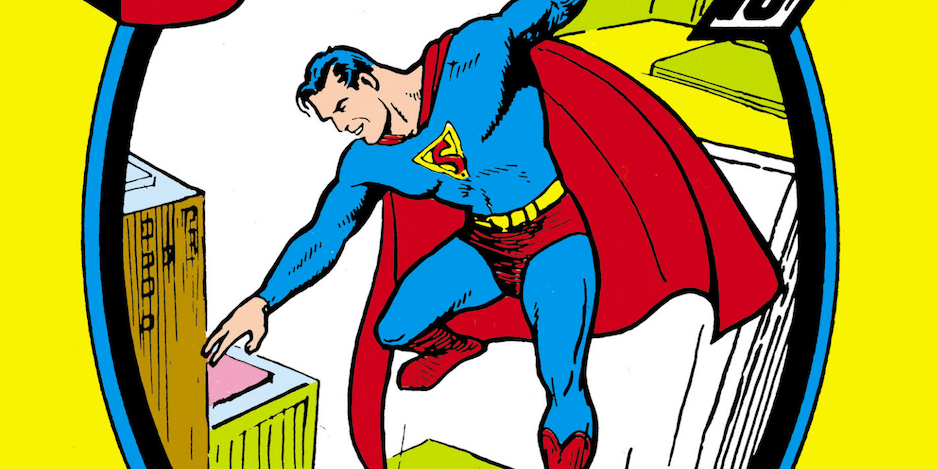
—
Superman turns 85 on April 18 — the date Action Comics #1 was released in 1938. To celebrate the Man of Steel, we have a lineup of groovy new material and a couple of favorites from the vaults that we are running across several days through the anniversary. Check the links at the bottom of this column, which first ran in 2020. Up, up and away! — Dan
—
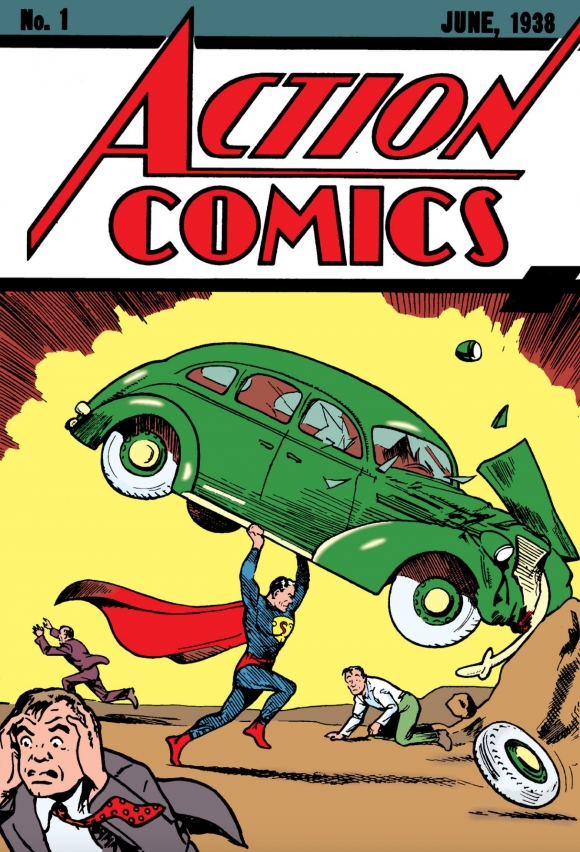
By FRED VAN LENTE
Happy Birthday to Joe Shuster, co-creator of Superman! In celebration, I did a deep dive of his work on Action Comics and the first few issues of Superman to bring you my TOP 13 favorites from his run.
Born in Toronto, moving to Cleveland when he was a teenager where he met fellow Supes creator Jerry Siegel, Shuster was not the world’s sharpest draftsman, but he had an instinctual knack for storytelling absolutely crucial to selling the new genre of superheroes — when you show people things they’ve never seen before, like a man smashing a car into the side of the building, you need to be absolutely sure they understand what the hell they’re looking at.
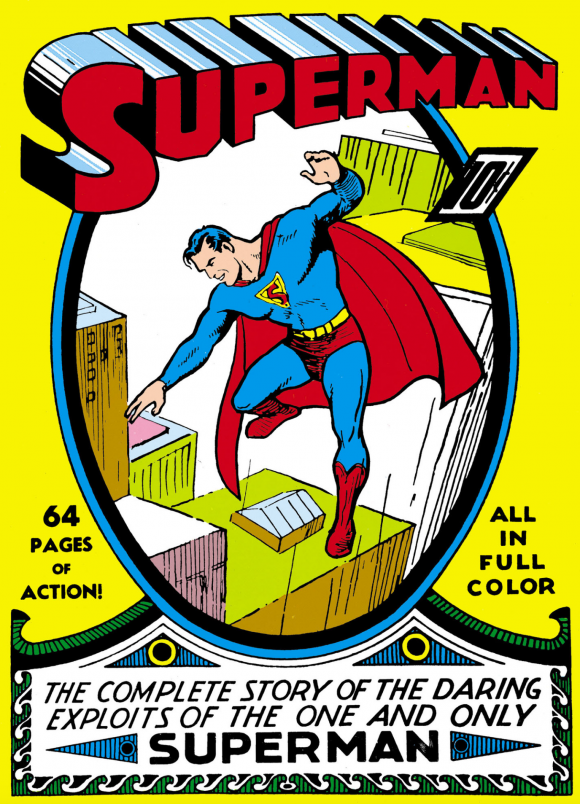
It’s exciting to read the early Superman stories and get a feel for Siegel and Shuster trying to figure out what best practices for the superhero genre were — kind of like reading The Murders in the Rue Morgue and seeing Poe try to feel his way through the mystery. In his first appearances, Superman is almost like Twain’s Mysterious Stranger, interjecting himself into situations and using his incredible strength and speed to torment evil-doers psychologically as much as physically. He’s a one-man EC Comic, ironically meting out poetic justice to toxic scumbags.
Part of the challenge I had in reading was figuring out which issues were actually drawn by Shuster. The abrupt popularity of Supes forced the boys to hire a bunch of uncredited assistants and other artists in Cleveland to help them keep up with demand. I made the somewhat arbitrary decision to go by his bibliography on Wikipedia. From that list, here’s what I recommend you check out. (Note that almost none of the early Superman stories have official titles.)
—
13. Superman #1. The majority of this first issue of Superman’s solo book are reprints from Action Comics #1-4, but it also includes Siegel and Shuster’s iconic two-page explication of Supes’ origin, with the naming of his home planet, Krypton. In this original version, the Kents give the Free Spaceship Baby they find to an orphanage, where he promptly trashes the place until the Kents change their mind and return to collect him. Pa Kent tells Clark to “hide [your great strength] from people or they’ll be scared of you,” a dictum I feel like Zack Snyder took a little too close to heart.
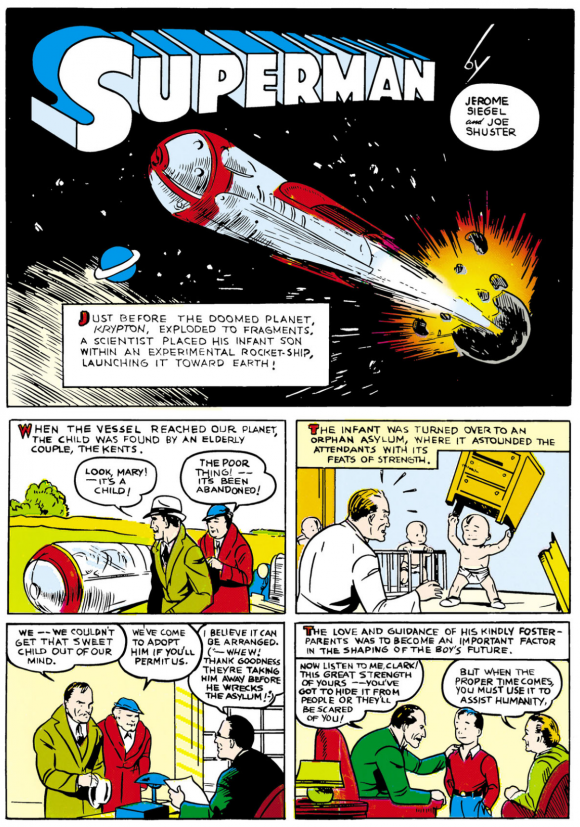
Also, new story pages provide much-needed context to the reprint of the first Superman story in Action Comics #1, which opens in media res. Keep in mind that Siegel and Shuster desperately wanted Superman to be a newspaper comic strip at first, and, as was the fashion in the funnies at the time, that first story dumps the reader right into the middle of Superman trying to stop an unjust execution.

—
12. Action Comics #4. God bless Joe Shuster, but he could only draw two heads, Superman’s and Lois Lane’s. This is a major plot point in this bonkers story, in which Superman decides to foil a crooked college football coach’s plans by drugging the star quarterback—who looks just like him—then taking his place and winning all the games the QB was supposed to throw. He also helps make time with the guy’s girlfriend, who, like every other woman in the series, looks exactly like Lois (it’s confusing). At the end of this episode of Touched By a Super-Angel, Clark has completely reformed this guy’s athletic and love life — you’ve never had a friend like him.
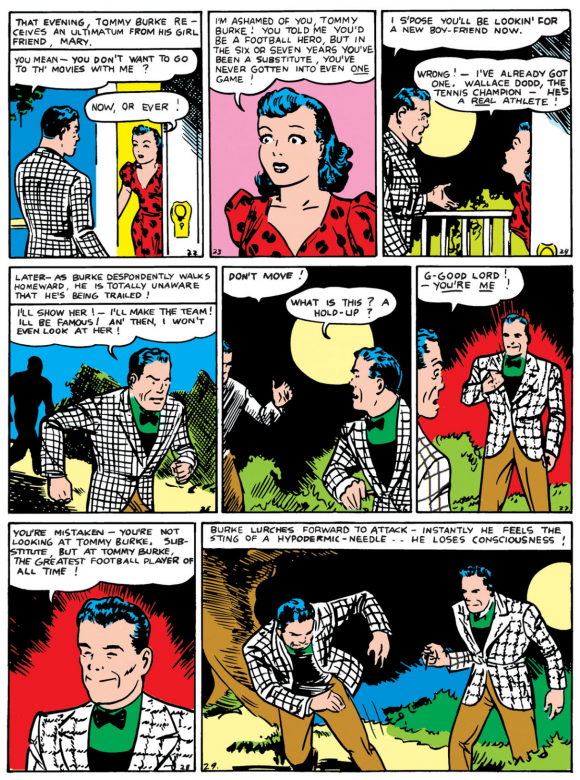
—
11. Action Comics #2. In this episode of #SuperJusticeWarrior, Clark targets munitions magnate and international douchebag Emil Norvell, fomenting revolution in a small European kingdom so he can sell both sides weapons. Emil is so terrified by Supes’ initial overtures that he enlists in the Army to get away from him, only to discover the Man of Steel has enlisted too. (Superman spends a surprising amount of time in his early appearances disguised as other people.) All the while, Clark Kent sends photos of the war back to his paper, The Daily Star — here specified as being in my (and Jerry Siegel’s) native Cleveland, booyah. Fighting on the front lines so terrifies Emil that he goes back to making firecrackers. Then Supes grabs the two rival generals and doesn’t let them leave until they sign a peace treaty. Less than two years later, Look magazine would enlist Superman to do basically the same thing to real-life combatants Hitler and Stalin.

—
10. Action Comics #6. Siegel and Shuster really start to hit their stride here, introducing what would become a genre standby: The Imposter Hero. A shady promoter says he has exclusive rights to appearances by Superman, which of course elicits Clark’s curiosity. Unfortunately, Lois gets to these guys first. She sees through their scheme immediately, so they decide to chuck her out a window. Rude. This tale inspired one of the better of the Fleischer Studios shorts (which are all worth watching — DC Universe has excellent prints of all 17).
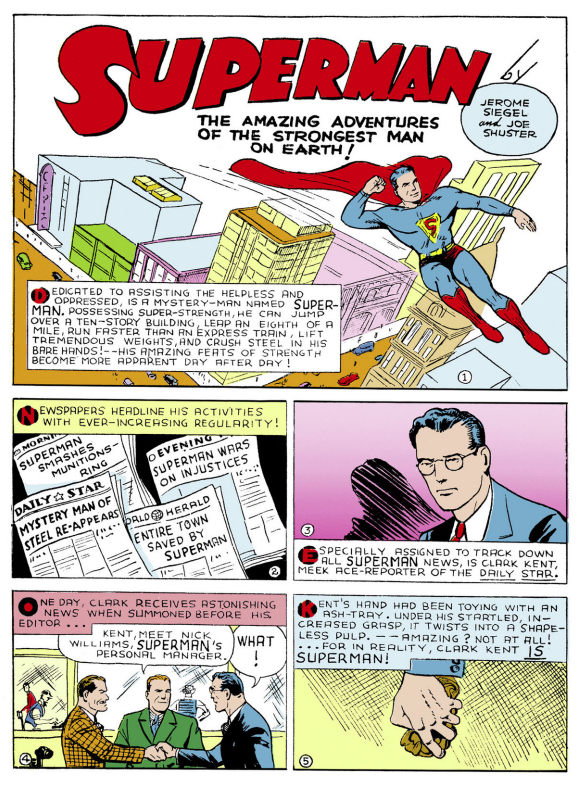
—
9. Action Comics #11. The suicide of an investor ruined in a crooked stock deal leads #SuperJusticeWarrior to get a job in oil fields to root out the miscreants. He punches open a “dead” well with his bare hands to increase the value of the company’s stock, and when the bad guys buy in heavy, he returns to smash the derricks down to ruin them financially. The moral of this story is: Do not fuck with Superman. He will end you. Then he’ll do stuff to your corpse. Seriously.
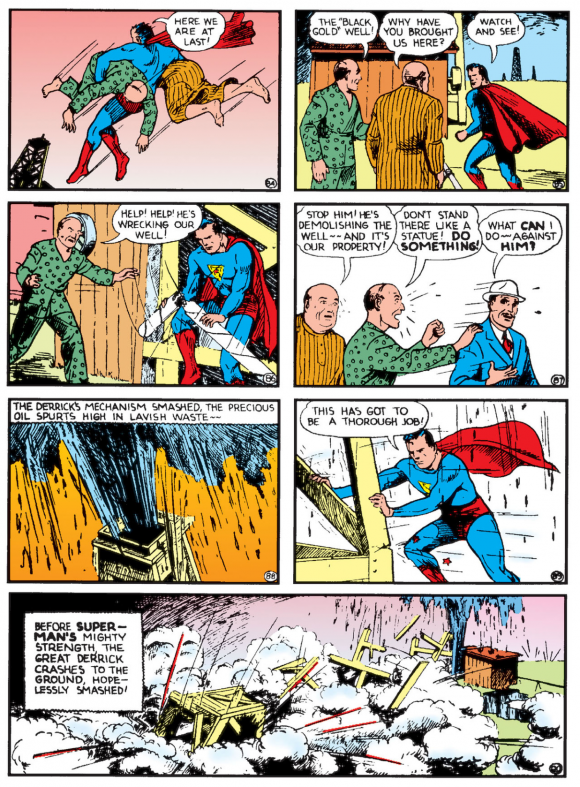
—
8. Action Comics #13. Clark investigates a taxicab protection racket and discovers that it is being run by the genre’s first-ever super-villain, the Ultra-Humanite, who wants to use his super-intelligence to dominate the world, starting with local cab companies, apparently the weak link in the social fabric. (Uber… Ultra …makes a lot more sense now.) Though Ultra isn’t smart enough to realize that trying to cut Superman’s head open with a buzz saw isn’t going to work. This is a pretty significant issue because halfway through, it transitions from a typical #SuperJusticeWarrior adventure into Supes fighting a mad scientist. It’d take a while, but Siegel and Shuster would eventually figure out which direction for the strip had legs.

—
7. Action Comics #20. After the seeming death of his arch-enemy the Ultra-Humanite last issue, Clark takes a vacation to Hollywood, where he rescues a Lois doppelganger movie star from assassination. That starlet takes all of her movie star pals on a yacht where she and the crew take everyone hostage. Superman volunteers to deliver the ransom himself, and in the starlet’s undersea lair, he discovers that the actress has been possessed by, you guessed it, the mind of the Ultra-Humanite. Like a lot of great Golden Age stories, one gets the impression that Siegel and Shuster were literally making this up panel to panel, but somehow its breathless insanity makes it all the more appealing.
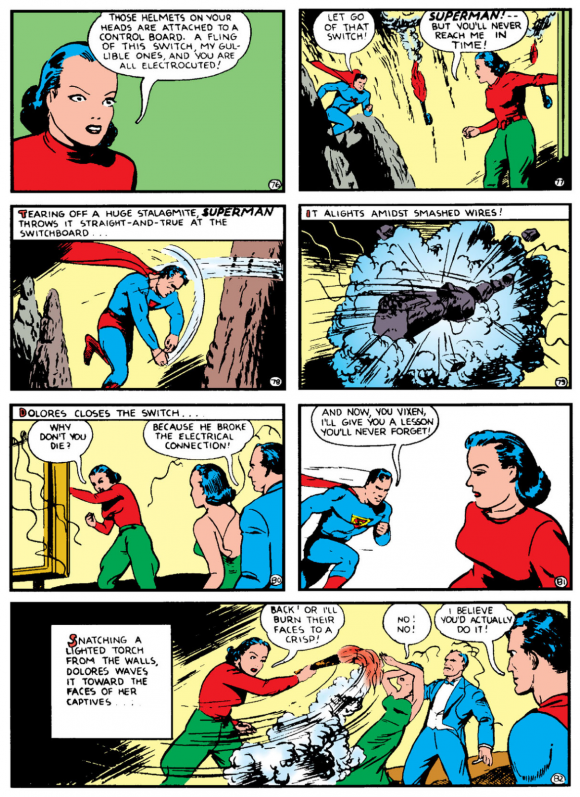
—
6. Action Comics #21. The Ultra-Humanite — who, again, looks exactly like Lois Lane now, it’s deeply confusing — holds Metropolis hostage with an atomic death-ray and demands Superman steal jewels for her. Clark agrees, but then the Humanite, because she’s a giant B-word, tips off the authorities. The Army is waiting for Superman when he shows up to collect the jewels. Like early Hulk, early Superman is at his best whaling the crap out of the U.S. Army. Superman gets the jewels and returns to the Humanite’s volcano lair to blow it to smithereens, apparently killing her, though Ultra would later transfer his brain into a white ape as part of DC’s ongoing gorilla fetish.
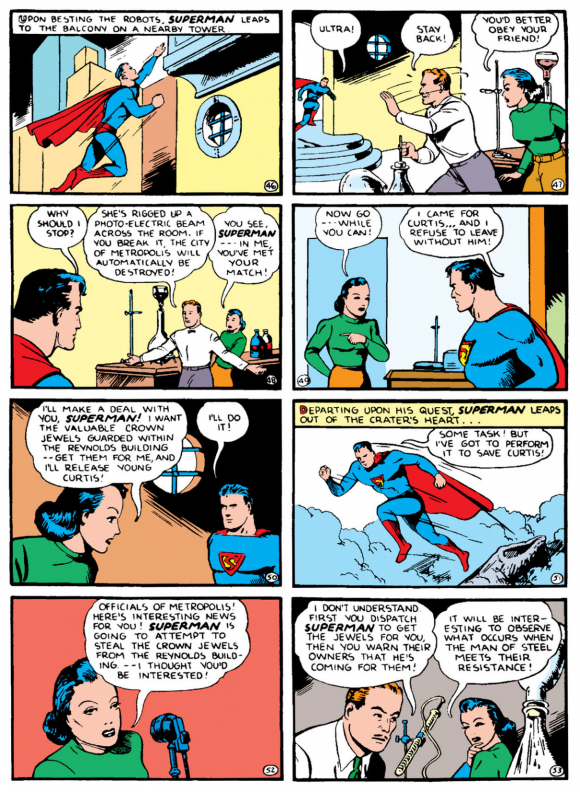
—
5. Action Comics #8. In this deeply insane comic book, Superman decides to help scrappy street urchins turn away from a life of crime by destroying the slum where they live with his bare hands. The U.S. Army is called out to stop him — incidentally, another great part of these early comics is that whenever anyone sees Superman their reaction is some variation of “WHO THE HELL ARE YOU?!” We are a long ways from it’s-a-bird-it’s-a-plane land. Once the Army’s bayonets (!) fail against Superman they send bombers after him, which turns the rubble of the slums into a much smaller, finer form of rubble, forcing the government to build better housing for the urchins so they won’t do so much crime. Woke Terrorist Superman is Best Superman.
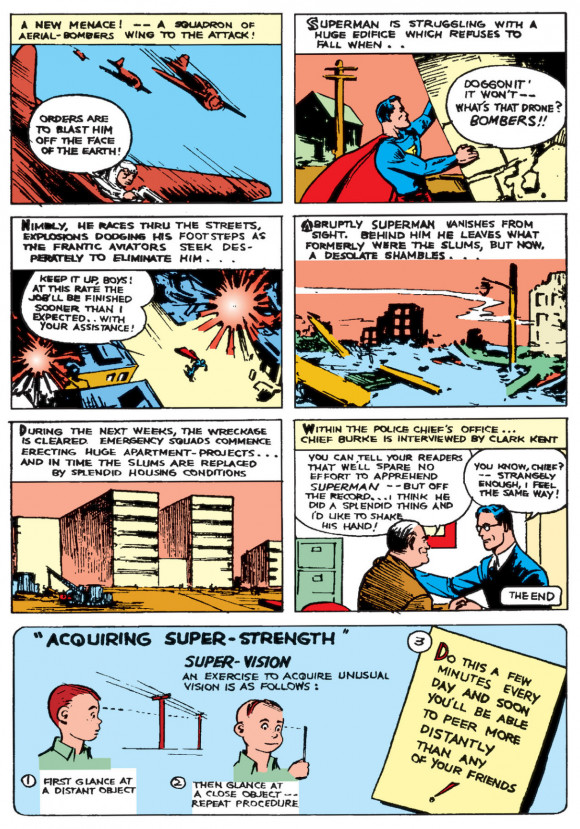
—
4. Action Comics #12. #SuperJusticeWarrior has made road safety his latest cause, and boy, does reckless driving turn his sun red. He busts into a radio station and threatens all of Metropolis to get their shit right or he’ll make them sorry. Does Metropolis listen? Hell, no. Metropolis is the worst. So Supes smashes up cars in parking and dealer lots. He personally picks up drunk drivers’ cars and flies them off the street.
Then some jackass actually hits Superman with his car. Granted, Superman was standing in the middle of the street at the time, but if you think he’s gonna let that slide, You Don’t Know Clark. Superman jumps into the guy’s backseat and tells him he’s the ghost of the guy he just hit and he’s going to haunt him for the rest of his days. Once again, this version of Superman actually prefers psychologically traumatizing his enemies to beating them up.
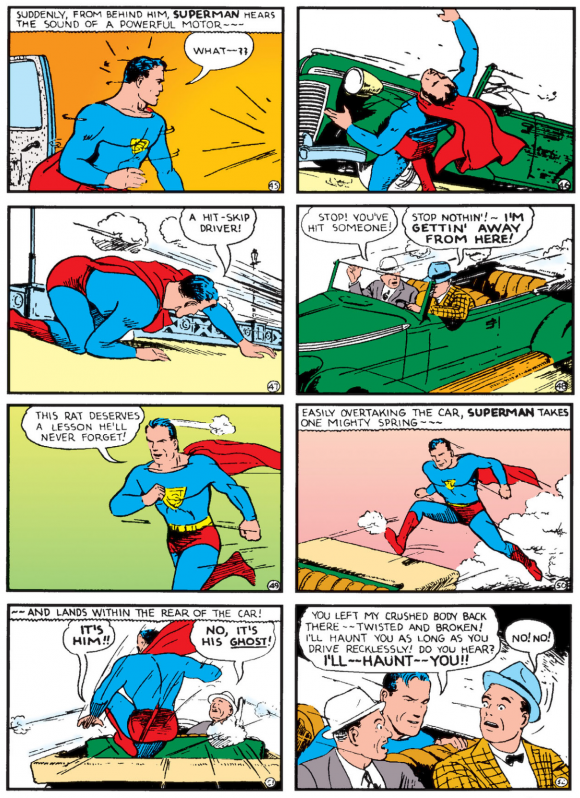
A cop slaps around a speeder pulled over because Superman is watching. Superman flies to a car factory and starts tearing it down until the owner promises to build safer cars. Superman carjacks the mayor of Metropolis and drives him around like a crazy person until the mayor swears he will enforce driving laws.
Was Jerry Siegel nearly hit by a car in a crosswalk before writing this crazy story? I am going to say yes.
—
3. Action Comics #3. I love this comic so much I barely know where to begin. A shoddily maintained mine collapses, nearly killing all the workers were it not for the timely intervention of #SuperJusticeWarrior. Swearing to bring Blakely, the greedy, crooked mine owner to justice, Superman disguises himself as a miner to spy on a party at Blakely’s house.
He is promptly captured by security and pretends to be a Peeping Tom with a Jerky Boys accent (“Beautiful ladies—much music—I read of these things—tonight I want to see them with own eyes”). Blakely is inspired to have this “miner” lead him and his guests down into the mines for a jolt of excitement. Once there, Superman reveals his true colors and dumps the whole place down on top of them, refusing to dig them out until Blakely swears to improve safety conditions.
Once again: Woke Terrorist Superman Is Best Superman.™
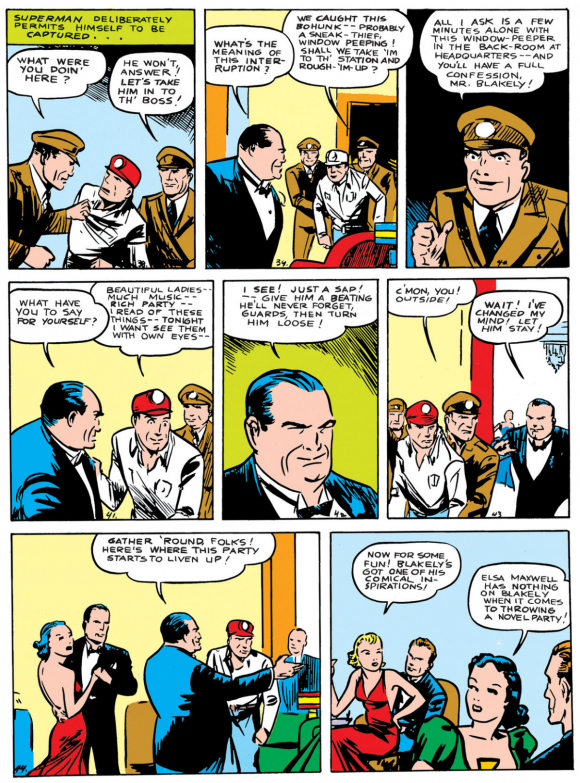
—
2. Superman #4. Luthor first appeared over in Action Comics as a successor to the finally deceased Ultra-Humanite, with an orange shock of hair that made him look like an evil Thomas Edison (or, as Nikola Tesla might say, Thomas Edison). Only later, possibly due to a studio artist mistaking him for Ultra, would Lex get his trademark bald pate. In those days, other than just generally being a cackling dick, Luthor’s main trick was to project his face on various random objects, like a tree, which, even by Golden Age standards, is deeply bizarre.
Here he returns with an artificial earthquake machine that he plans for something worse than a real estate deal; when Superman arrives to foil him, though, he proposes a series of challenges, pitting Ediso—uh, Luthor’s super-machines against Kryptonian super-muscles. It’s a test of speed, strength and constitution right out of Greek myth, and ends with Luthor trying to trap Supes in a collapsing canyon. It’s the first great Luthor/Superman tussle and provides the model for their long-running rivalry.
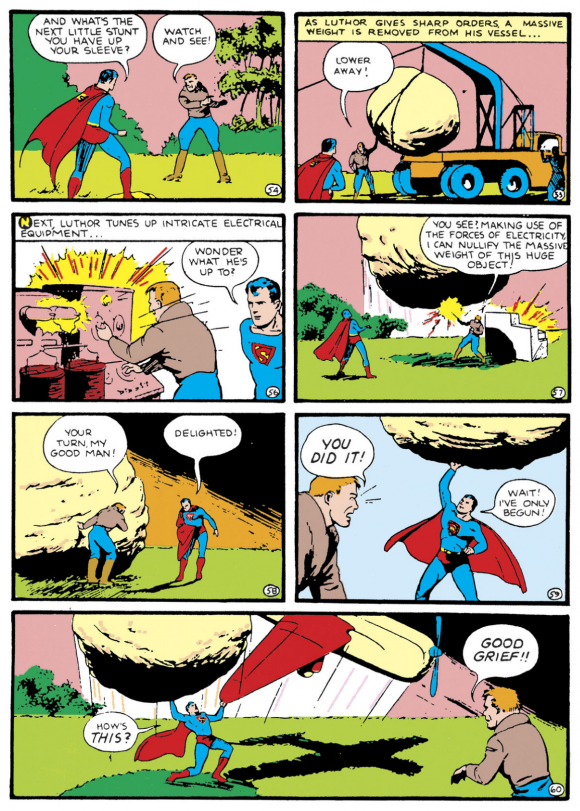
—
1. Action Comics #5. That said, Superman’s primary antagonist for the first few decades of his existence was truly Lois Lane, who keeps trying to scoop Clark Kent for stories and figuring out Superman’s true identity, both because she’s a great reporter and because it’ll be easier to romance him that way. That relationship really gets defined starting here.
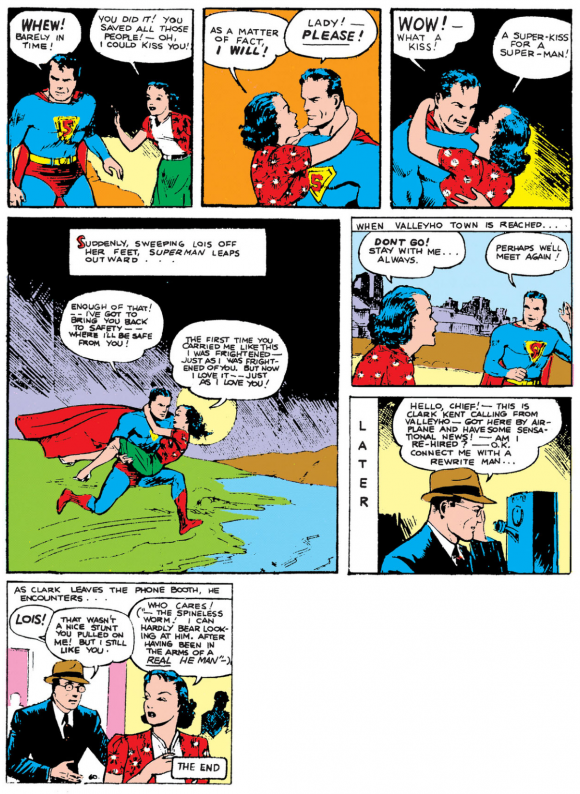
After roughing up wife beaters and lynch mobs the previous few issues, Superman gets a real challenge — he’s up against a collapsing dam, the rushing waters of which Shuster depicts with smashing aplomb. There’s also a good character bit as Lois tricks Clark into covering a completely different story so she can rush off to cover the floodwaters with the unerring sense for self-destruction of a toddler running into traffic, necessitating Supes’ rescue.
Lois really falls hard for Superman for the first time, and her narrow escape from a doomed car must have helped inspire a similar, iconic sequence featuring these two.
—
MORE
— ACTION COMICS #309: The Issue That Sums Up SUPERMAN in the Silver Age. Click here.
— 13 REASONS Warner Bros. Discovery Needs to Stream ADVENTURES OF SUPERMAN. Click here.

July 10, 2020
Happy birthday, Mr. Shuster.
July 12, 2020
Greetings from Canada!
Toronto is Joe Shuster’s birthplace!